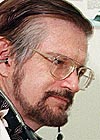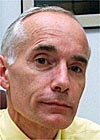By Beverly Creamer
Advertiser Staff Writer
With the genetic-research market booming, Hawai‘i medical research groups are positioning themselves and forming partnerships so the state can cash in on the growth.
 |
| "The sky's the limit" for Hawai'i, said David Curb.
Advertiser library photo • Aug. 10, 1996 |
"The sky’s the limit if we can facilitate health research in Hawai‘i," said Dr. David Curb, chief executive officer and medical director of the Pacific Health Research Institute, and a lead player in these moves. "It could be a new industry."
Hawai‘i attracts 0.2 percent of the $11.1 billion annual National Institutes of Health (NIH) budget for research grants, Curb said. In 1998, that amounted to just $21.6 million, placing Hawai‘i 42nd among the 50 states.
With collaborations, he said, "we can have a major piece of the pie," creating new jobs and broadening the local economy.
Curb has put together groups over the last 10 years that have attracted $50 million to $60 million in research money to the state.
Hawai‘i, Curb said, is on the verge of being a bigger national player — if the local players work together.
That meshes precisely with the vision that Edwin Cadman, dean of the John A. Burns Medical School, has for a new $150 million medical school in Kaka‘ako, with 25 new researchers pulling in $1 million a year each in research money, along with another $14 million for "infrastructure" support, which is an automatic part of NIH grants.
"We have to jump on it fast," Cadman said.
For Cadman, another key player, anything less than an all-out effort would not serve the state well, he said.
"We’re trying to do our part by creating research space and developing opportunities for basic and clinical research," Cadman said. "We can become a bigger player."
 |
| Edwin Cadman envisions world-class programs.
Advertiser library photo • April 11, 2000 |
With retirements, normal turnover and aggressive recruiting, the medical school could see 50 to 60 new faculty members in the next five years, Cadman said.
"We have wonderful faculty already doing research," he said. "It’s just that we don’t have enough of them."
Other states with well-developed research capabilities already have boarded the boom train created by the completed map of the Human Genome, Curb said. The key is even more cooperation among Hawai‘i institutions, so the state "isn’t left at the station," he said.
"There are a lot of opportunities to be part of medical research but there’s no one institution that’s sufficiently developed in many areas to be competitive with Mainland universities and research institutions," Curb said.
$3.8 million in grants
A cooperative group that includes PHRI, Kuakini Medical Center, the Queen’s Medical Center, the Medical School and Stanford University in California will receive $3.8 million from NIH to build a Hawai‘i-based collaborative network for population genetics.
These two grants include:
 $1.9 million to continue to look for genetic clues to family-linked high blood pressure. $1.9 million to continue to look for genetic clues to family-linked high blood pressure.
 $1.9 million to look for genetic links to longevity in Hawai‘i’s large Asiangene pool. $1.9 million to look for genetic links to longevity in Hawai‘i’s large Asiangene pool.
Called PacGen, the Pacific Genetic Epidemiologic Study on Aging, this will be a study of life-span and brain function as related to genetics and environmental factors in Japanese-American men and their families.
The original study began with 9,000 men three decades ago as the Honolulu Heart Program. Because the men have been studied all that time, there’s a great deal of data to be mined.
While the last three decades of research have focused on the impact of diet and lifestyle on health and longevity in the Heart Program study subjects, researchers now will overlay the genetic factor.
"A lot of people are looking at (the genetics of) different ethnic groups but not at mixtures," said Timothy Donlon, a geneticist at the Queen’s Medical Center’s new Genetics Laboratory and director of the molecular laboratory.
Hawai‘i’s rich mix of ethnic groups gives the state an advantage in being able "to look at the interaction of genes," Donlon said. "It’s almost like the hapa kids are like a new race of people."
‘Critical mass’
Both Curb and Cadman want to see an influx of geneticists of every stripe. The Queen’s Medical Center is recruiting and building a genetics staff.
Within two years, the full human genome will be accessible, Curb said. "We’re setting ourselves up to access that," Curb said.
Along with the expansion of its genetics work, Queen’s recently created the Center for Biomedical Research, to be led by scientist Dr. Reinhold Penner, whose work on immune responses was recently detailed in "Nature."
Penner, too, will try to lure top scientists to Hawai‘i, a key ingredient in creating what he calls "critical mass" that lures more resources.
"The critical mass is always something that’s required," Penner said. "Of course, all of these people must be excellent. So before we can actually get all those NIH funds, we need to invest to get people here, and that’s what I’m trying to do.
Roadblocks lifted
In the past, geography hampered Hawai‘i’s chances to recruit the best, but those problems are evaporating.
The Internet makes data transmission instantaneous. As well, compared with skyrocketing California housing prices, Hawai‘i is beginning to look economically feasible.
"The other thing you need for collaboration is evidence of collaboration already," Cadman said.
The medical school already has a track record of collaboration with independent hospitals here, which, he said, eliminates the need for a research hospital as part of the school itself.
Cadman wants to develop a world-class sports medicine program, an academic department in complementary and alternative medicine, one in Native Hawaiian health, and a "patient simulation" center that would, in turn, generate income.
The latter would include:
 Use of computerized mannequins to simulate anything from a heart attack to a stroke or an unknown disease. Physicians can be trained using such mannequins. Use of computerized mannequins to simulate anything from a heart attack to a stroke or an unknown disease. Physicians can be trained using such mannequins.
 Virtual reality. Using the Maui-based supercomputer, the medical school could make full use of 3-dimensional imaging to train new physicians and re-certify practicing physicians. Virtual reality. Using the Maui-based supercomputer, the medical school could make full use of 3-dimensional imaging to train new physicians and re-certify practicing physicians.
"We can create a world-class simulation center for people from the Mainland and Asia to become educated and test their skills," Cadman said.
Said Donlon: "We’re not fighting for local dollars. We’re bringing in outside resources."
[back to top] |


